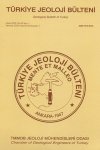
-
2025
-
2024
-
2023
-
2022
-
2021
-
2020
-
2019
-
2018
-
2017
-
2016
-
2015
-
2014
-
2013
-
2012
-
2011
-
2010
-
2009
-
2008
-
2007
-
2006
-
2005
-
2004
-
2003
-
2002
-
2001
-
2000
-
1999
-
1998
-
1997
-
1996
-
1995
-
1994
-
1993
-
1992
-
1991
-
1990
-
1989
-
1988
-
1987
-
1986
-
1985
-
1984
-
1983
-
1982
-
1981
-
1980
-
1979
-
1978
- 1977
-
1976
-
1975
-
1974
-
1973
-
1972
-
1971
-
1970
-
1969
-
1968
-
1966
-
1964
-
1963
-
1961
-
1959
-
1958
-
1955
-
1954
-
1953
-
1952
-
1951
-
1950
-
1949
-
1948
-
1947
Abstract: In the investigated area an ophiolitic melange unconformably overlain by Neogene sediments is exposed.The regional structure is charaeterized by narrow gravity faults of various strikes and to a lesser degree by folds. inaddition, there are several thrust faults and other local folds striking nearly E-W.Two structures were observed at the north and south margins of the investigated area. These form the highestparts of the region and consist of crystallized limestone blocks. The limestone blocks are covered by marine Miocenesediments at the east and the south of the area.During the Alpine orogeny and in close connection with it structures such as strike and dips, schistosity, boudinage, lineation, faults, joints, folds and unconformities were developed.
Abstract: Sancaktepe granite whieh is situated in Koeaeli peninsula to the north of sea of Marmara is known geolo-gically tobe Silurian in age. The purpose of this study is to determine the absolute age of the massif using geoehronologie methods andthe origin of it throungh tine data provided by geology, petrography and geochemistry. The age of the massif was found to be 25+--5 million years by Rb-Sr isochron method. K-A measurements made on the biotites of the granite show that this massif is 254million years old. On the basis of both methods which gave similar results, it could ,be indicated that the granite has onephase of fonnation during Saxonian (Permian) time by post-orogenic movements. This granite is alkaline and rich inquartz was hîghly evolved from the point of view of geochemistry. Initial ratio of Sr is very low, and this proves thatthe granite is deep seated, intrusive and juvenile in character.
Abstract: In the area studied Cambrian to Triassic systems are distinguished by the use of conodonts and their fauna isdeseribed briefly. It is believed that the metamorphic Alanya massif overlays the Sedre Triassic as a nappe, forming atectonic window. Hadimopanella oezgueli n. gen. n. sp. (incertae sedis) and three new conodont species are established.
Abstract: Recent studies of the Tertiary volcanism in the Eastern Black Sea region (Gümüşhane-Alucra-ŞebinkarahisarGölköy) revealed that the voluminous andesites, dacites and pyroclastics are of Lutetian age. The suite is at the calcic end ofthe calc-alkaline suite. The rocks are oversaturated, quite sodic with Na2O > K2O and generally rich in Al2Oa. The AFM trend,the alkali enrichment and the trend of total iron-MgO ratio of the analysed rocks show that the chemical composition of theEocene volcanics of the Black Sea region are somewhat similar to the composition of the volcanic products which occur alongthe closing boundaries of the plates. it is probable that a trench occurred along the north Anatolian Land Continentalmargin. As the slab of oceanic floor of the North Anatolian Tethys, and the interstitial water incorporated in slab,descended beneath the North Anatolian land the voluminous calc-alkaline andesites resulted during the Lutetian. Theoccurence of the batholitic granites of Oligocene age, which are intensely exposed in the Black Sea region, implies thatthe rate of the plate motion was higher during Oligocene, as a consequence, high monutains emerged and regressionoccurred.
Abstract: Kurdoğlu contact metamorphic zone consists of metapelitic rocks which surround the Gümüşhane granitepluton. These rocks were influenced by a complex metamorphic process before granite emplacement. The emplacement ofgranite increased the degree of metamorphism of metapelitic rocks from grencshist facies to hornblende-hornfelds facies.Then retrograde metamorphism took place in contact zone with the influence of deuteric and metasomatic processeswhich coincide with the late phases of the granite emplacement.Kurdoğlu contact metamorphic zone is characterised by absence of aluminum silicate (AL2O5) minerals (fibrolite andsillimanite). Another feature is the formation of an Fe-Mg mineral (almandine) whose P-T stability range is very narrow, againstcordierite. The formation of almandine must be related to high M/FM ratio in rock.Sillimanite occurs over biotites and in replacements of them. This relation was formed as a result of metasomaticoperations.Occurrence of temperature effect of granite in a very narrow belt is the result of intrusive pressure being at leastequal to lithostatic pressure. For this reason, quickly coolingmagma in the cold neighbouring rocks could not develop aheated zone of expected dimensions.
Abstract: The Steneofiber remains collected in Muğla-Yerkesik-Çatakbağyaka are studied. This genus is represented by twospecies: Steneofiber minutus ozansoyi n. s n. sp. and Steneofiber cf. jaegeri Kaup. The former is compared with the small Steneofiberfrom the Upper Miocene of the Middle Europe.

 TMMOB
TMMOB